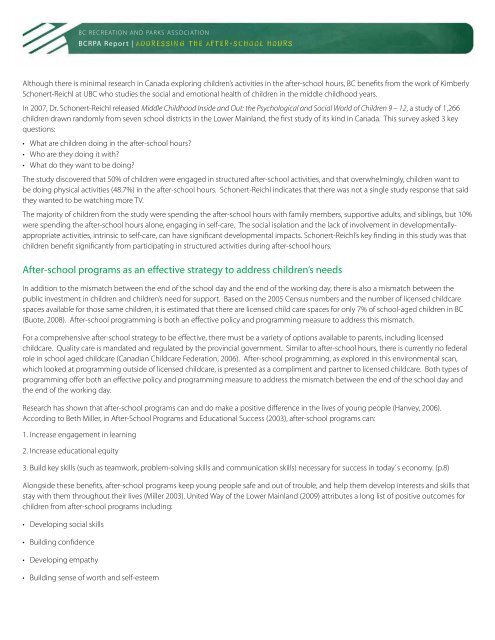BCRPA Report: Addressing the after-school hours - Middle ...
BCRPA Report: Addressing the after-school hours - Middle ...
BCRPA Report: Addressing the after-school hours - Middle ...
Create successful ePaper yourself
Turn your PDF publications into a flip-book with our unique Google optimized e-Paper software.
10 | www.bcrpa.bc.ca<br />
BC RECREATION AND PARKS ASSOCIATION<br />
<strong>BCRPA</strong> <strong>Report</strong> |<br />
Although <strong>the</strong>re is minimal research in Canada exploring children’s activities in <strong>the</strong> <strong>after</strong>-<strong>school</strong> <strong>hours</strong>, BC benefits from <strong>the</strong> work of Kimberly<br />
Schonert-Reichl at UBC who studies <strong>the</strong> social and emotional health of children in <strong>the</strong> middle childhood years.<br />
In 2007, Dr. Schonert-Reichl released <strong>Middle</strong> Childhood Inside and Out: <strong>the</strong> Psychological and Social World of Children 9 – 12, a study of 1,266<br />
children drawn randomly from seven <strong>school</strong> districts in <strong>the</strong> Lower Mainland, <strong>the</strong> first study of its kind in Canada. This survey asked 3 key<br />
questions:<br />
• What are children doing in <strong>the</strong> <strong>after</strong>-<strong>school</strong> <strong>hours</strong>?<br />
• Who are <strong>the</strong>y doing it with?<br />
• What do <strong>the</strong>y want to be doing?<br />
The study discovered that 50% of children were engaged in structured <strong>after</strong>-<strong>school</strong> activities, and that overwhelmingly, children want to<br />
be doing physical activities (48.7%) in <strong>the</strong> <strong>after</strong>-<strong>school</strong> <strong>hours</strong>. Schonert-Reichl indicates that <strong>the</strong>re was not a single study response that said<br />
<strong>the</strong>y wanted to be watching more TV.<br />
The majority of children from <strong>the</strong> study were spending <strong>the</strong> <strong>after</strong>-<strong>school</strong> <strong>hours</strong> with family members, supportive adults, and siblings, but 10%<br />
were spending <strong>the</strong> <strong>after</strong>-<strong>school</strong> <strong>hours</strong> alone, engaging in self-care. The social isolation and <strong>the</strong> lack of involvement in developmentallyappropriate<br />
activities, intrinsic to self-care, can have significant developmental impacts. Schonert-Reichl’s key finding in this study was that<br />
children benefit significantly from participating in structured activities during <strong>after</strong>-<strong>school</strong> <strong>hours</strong>.<br />
After-<strong>school</strong> programs as an effective strategy to address children’s needs<br />
In addition to <strong>the</strong> mismatch between <strong>the</strong> end of <strong>the</strong> <strong>school</strong> day and <strong>the</strong> end of <strong>the</strong> working day, <strong>the</strong>re is also a mismatch between <strong>the</strong><br />
public investment in children and children’s need for support. Based on <strong>the</strong> 2005 Census numbers and <strong>the</strong> number of licensed childcare<br />
spaces available for those same children, it is estimated that <strong>the</strong>re are licensed child care spaces for only 7% of <strong>school</strong>-aged children in BC<br />
(Buote, 2008). After-<strong>school</strong> programming is both an effective policy and programming measure to address this mismatch.<br />
For a comprehensive <strong>after</strong>-<strong>school</strong> strategy to be effective, <strong>the</strong>re must be a variety of options available to parents, including licensed<br />
childcare. Quality care is mandated and regulated by <strong>the</strong> provincial government. Similar to <strong>after</strong>-<strong>school</strong> <strong>hours</strong>, <strong>the</strong>re is currently no federal<br />
role in <strong>school</strong> aged childcare (Canadian Childcare Federation, 2006). After-<strong>school</strong> programming, as explored in this environmental scan,<br />
which looked at programming outside of licensed childcare, is presented as a compliment and partner to licensed childcare. Both types of<br />
programming offer both an effective policy and programming measure to address <strong>the</strong> mismatch between <strong>the</strong> end of <strong>the</strong> <strong>school</strong> day and<br />
<strong>the</strong> end of <strong>the</strong> working day.<br />
Research has shown that <strong>after</strong>-<strong>school</strong> programs can and do make a positive difference in <strong>the</strong> lives of young people (Hanvey, 2006).<br />
According to Beth Miller, in After-School Programs and Educational Success (2003), <strong>after</strong>-<strong>school</strong> programs can:<br />
1. Increase engagement in learning<br />
2. Increase educational equity<br />
3. Build key skills (such as teamwork, problem-solving skills and communication skills) necessary for success in today`s economy. (p.8)<br />
Alongside <strong>the</strong>se benefits, <strong>after</strong>-<strong>school</strong> programs keep young people safe and out of trouble, and help <strong>the</strong>m develop interests and skills that<br />
stay with <strong>the</strong>m throughout <strong>the</strong>ir lives (Miller 2003). United Way of <strong>the</strong> Lower Mainland (2009) attributes a long list of positive outcomes for<br />
children from <strong>after</strong>-<strong>school</strong> programs including:<br />
• Developing social skills<br />
• Building confidence<br />
• Developing empathy<br />
• Building sense of worth and self-esteem


